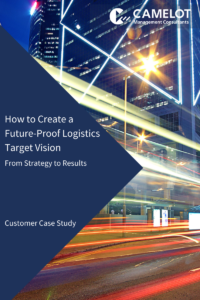In today’s rapidly evolving logistics landscape, organizations face numerous challenges in their quest for operational excellence through continuous efficiency gains. Logistics organizations endeavoring to be cutting-edge necessitate a strategic approach to uncover quick optimization potential to be able to operate efficiently and to significantly add value to the overall organization. The Value Generation Framework for Logistics aims to achieve this goal.
CAMELOT’s Value Generation Framework for Logistics is an innovative tool to create a systematic and structured approach to value creation within your logistics operations and beyond. It guides logistics organizations towards enhanced efficiency, cost reduction, compliance, and revenue growth. Consequently, it helps organizations identify areas where they can create value for their customers, stakeholders, and shareholders.
Driving Efficiency with the Value Generation Framework
The Value Generation Framework is geared towards improving four strategic levers of a logistics organization. It achieves this goal by investigating a host of dedicated opportunities known to yield substantial efficiency gains in their respective strategic domains.
Said opportunities are sourced from our deep knowledge of logistics best practices as well as emerging technologies. They include spill-over effects into domains of the other levers to fully maximize identified efficiency gains. Furthermore, the Value Generation Framework features an integrated approach with our existing service offerings such as the Process Reference Model which we use to map a company’s business processes to industry-wide best practices. This facilitates not only a rapid identification of suitable opportunities but also inherently provides robust categorization.

The Four Strategic Levers of the Value Generation Framework
Ensure compliance & increase service
With customers expecting ever-increasing service levels, compliance and service excellence are of primary importance. The opportunities presented at this stage enable organizations to ensure service level compliance by investigating overcapacity, finding opportunities for a dedicated fleet, or identifying adjustments of lead times. The alignment of logistics processes with market requirements and customer expectations can yield a competitive edge and enhance customer satisfaction for a company’s logistics operations.
Reduce logistics costs
Logistics costs have a direct impact on the bottom line. Through effective supply chain optimization, route planning, carrier selection, and utilization of state-of-the-art IT solutions, organizations can achieve substantial savings in their logistics expenses. The Value Generation Framework helps organizations analyze their current logistics cost structure, identify cost-saving opportunities, and implement strategies to optimize their logistics spend.
Increase revenue
Beyond cost reduction, the Value Generation Framework also focuses on revenue enhancement. By leveraging logistics as a strategic differentiator, organizations can explore avenues for revenue growth. This includes optimizing transportation networks, improving order fulfilment cycles, and identifying new market opportunities. The framework provides a structured approach to identify revenue-generating initiatives and implement strategies to capitalize on them.
Reduce process costs
Process efficiency is a crucial aspect of logistics operations. By streamlining processes, eliminating redundancies, and optimizing workflows, organizations can significantly reduce costs directly linked to transportation, warehousing, or inventory management processes. The Value Generation Framework provides a systematic approach to identify and implement process improvements that lead to cost reductions without compromising service levels.
The Methodology of the Value Generation Framework
At CAMELOT, we understand that every transport management initiative is unique and therefore requires a holistic approach from strategy to results. Thus, the methodology behind the Value Generation Framework, as a comprehensive and proven value-adding process, contains four steps and is designed in a modular manner to facilitate a wide range of possible applications. Based on an agreed-upon project scope, the four stages of the value creation process can be investigated separately or jointly. However, we strongly recommend an end-to-end approach to truly leverage identified efficiency gains.

Step 1: As-is analysis
By conducting a thorough analysis of the current transport management setup, including transport structure analysis and visualizations, maturity assessments, and gap identifications, stakeholders gain a clear understanding of potent and quickly implementable opportunities relevant to their particular transport organization.
Step 2: Value proposition
Based on the previous analysis, the subsequent stage is geared towards the identification of relevant opportunities hand-picked from the Value Generation Framework. This includes creating a tailored future state vision and formulating a compelling value proposition that outlines the expected business benefits for the pertinent organization.
Step 3: Operating model re-design
To realize the value proposition, organizations embark on a comprehensive journey to re-design their operating model. This may include process re-engineering, addressing organizational impact, and targeting the IT landscape to enable seamless integration in support of the new operating model.
Step 4: Implementation of value proposition
The final stage focuses on embedding the proposed value proposition into the organization’s processes. This includes adapting IT systems, providing extensive training to employees, and ensuring a successful go-live, to maximize the identified efficiencies.

Holistic Approaches for Logistics Organizations
By following the methodology as outlined in conjunction with our dedicated tools and industry knowledge, CAMELOT assures a systematic and structured approach to identify new opportunities for efficiency gains and saving potential in your logistics operations, with the essence of quickly creating additional value.
The CAMELOT Value Generation Framework for Logistics identifies improvements in logistics organizations. If implemented, logistics leaders gain efficiency improvements with lower cost, better compliance, improved processes and contributions to the organization’s higher revenue growth.

